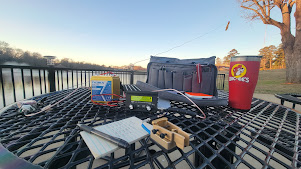(UPDATE AT END) I love
QRP Lab's stuff and and I've really enjoyed the
QDX! I recently took my QDX and built it into a weather-resistant case I picked up at
Harbor Freight. I used
marine-grade HDPE plastic to create a panel that fit in the lid of the box. The box happened to have small cylinders in each of the corners, so I used by tap kit and cut some threads in them for screws. Then I mounted the QDX, a RaspberryPi-4 computer and
7-inch HMDI screen that runs on 12 volts. I routed all the wires behind the panel and down to the box.
For the time being, I'm using pull-apart foam to hold things in place but I'm considering a more permanent panel in the bottom as well. Using a 6-amp/hour LiFePO4 battery, I powered everything in the box. The Pi and the screen run on a USB plug connected to the battery and the QDX runs at 12v via a buck converter to keep the voltage from spiking and risk blowing the power transistors.
 |
| Stations which heard by signal on 30m |
I took the setup to my local park and hung my
End-Fed-Half-Wave (EFHW) multi-band antenna in a tree and configured it for 40 meters. I fired up
WSJT-X and almost instantly I was decoding FT8 stations. I made a few contacts before switching to 10 Mhz. Fortunately, 30 meters was HOT with station consistently loud across the band. I then switched to
JS8Call and, again, there were lots of stations. I sent a heartbeat and got a dozen responses. Sadly, I called CQ for about 15 minutes with no takers.
Still, I seemed to be getting out nicely, especially according to PSKReporter. With the sun starting to set, I packed things up nd headed to the house. All in all, I am very pleased with the rig and the whole setup. Now I'm looking forward additional trips out into the wild!
UPDATE: I have now fried TWO Raspberry Pi 4Bs using my setup. There was no obvious reason why, but both times, when I turned the system on, the Pi got VERY hot and smelled like it was burning. After disconnecting and trying again, the Pis were dead. After a discussion on the Pi Community Forum (https://forums.raspberrypi.com/viewtopic.php?p=2118667#p2118667) I decided to remove the overvoltage diode on each Pi and...BAM...they worked again. However, they are no longer protected from overvoltage. I've ordered some replacement diodes to repair the boards.
As far as why, the only thing I can guess is that the "Quick Charge" USB socket misunderstood the Pi and thought it wanted more than 5v. They can deliver up to 24v at times. Another possibility is that the HDMI screen, powered by the battery as well, may have back-fed some power on the HDMI port, helping to trigger the USB socket. So, I've decided to replace the USB sockets with 12v-in-5v-out buck converters to ensure the Pi only get 5 volts.
 |
| Stations which heard by signal on 40m |

















